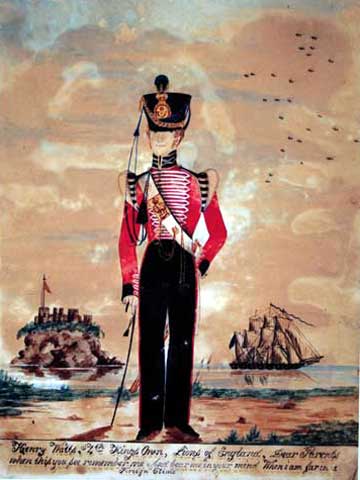Museum Display Information
Australia

Within eighteen years of the discovery of Australia in 1770 the
colony was used as a convict settlement. After 1810 when local guards
rebelled, the guarding of the convicts was given to the British Army. In
1831 the King's Own were sent out to undertake this duty.
Between 1831 and 1832 a detachment of King's Own soldiers travelled with
each of the twenty nine convict ships, guarding the prisoners during the
seven month journey.
One such journey, on board the Jane, took place in 1831 and we are
fortunate that the events are recorded in the diary of Captain
George Mason, a King's Own officer since 1826
Mason tells us that the daily routine was boring for both the soldiers
and the convicts. The only events to vary the routine were "plots and
fights amongst the convicts, courts of inquiry, inspection of mens
equipment, trouble with the women, catching sharks and the ceremony of
initiation by Neptune when the ship crossed the equator."
Mason described a typical day, writing on Friday 15th July 1831:
"Breakfast finished, generally with small appetites, and still smaller
talk, the table is cleared, and all betake themselves to reading,
writing, physicking, and Parading till 12 o'clock, when the Officers of
the Ship are all looking out for the Sun, and we are all anxiously
waiting to know whether we have lost or gained ground during the last
twenty four hours."
"After lunch of a leg and arm of duck or fowl, or a bit of salt beef we
all betake ourselves to our different modes of killing time, (deep study
quite out of the question the various noises of Womens tongues, cooks
pounding Cocoa, Sheep, Pigs, Geese, Ducks......putting all serious
reflection quite out of the power of man."
Dinner for the officers lasted from 3 o'clock in the afternoon until
close on seven. Nearly every night an impromptu concert took place with
some of the more favoured convicts and the men of the guard amusing each
other for about an hour.
The duty of the King’s Own was to maintain order amongst over twenty
thousand convicts in New South Wales The main penal settlements were at
Van Dieman’s Land, Moreton Bay and Port Macquarie. Soldiers were called
upon to chase down escaped convicts, restore order when they rioted, and
to take charge of working parties.
Convicts were deployed on many construction works. Lieutenant Otter, a
sergeant and 42 men men were placed in charge of an ‘iron gang’ working
on the road to Bathurst across Emu Plains. Another detachment oversaw
the construction of a breakwater at Newcastle.
As well as the prison population and the guarding regiments, Australia
was also the home to free settlers, released convicts and their
descendants. The land offered great opportunities, and some soldiers
decided to make Australia their home.
Captain Lonsdale became so attached to the settlement at Port Phillip
that he left the Regiment instead of transferring to India in 1837.
Lonsdale became the ‘Chief Agent of Government’ reporting directly to
the Governor in Sydney. Over the next eighteen years he oversaw the
expansion of Port Phillip into what became Melbourne.
The foundation of present day Australia was well underway.
Transportation of criminals ceased in 1839 at the same time the influx
of settlers rapidly expanded.

Private Henry Watts, of the Light Company 4th Foot, painted in
spring 1831 before his departure for Australia. The inscription reads:
“Henry Watts, 4th King’s Own, Lions of
England, Dear Parents when you see this remember
me And bear me in your mind When i am far in a Foreign Clime.”
On the reverse of the picture is
written: “Painted by Charles Dean later 15th Regiment....for H
Watts....Chatham,
Kent.”
KO1324/01 Purchased with grant aid from the Army Museums
Ogilby Trust.
John Winder
From the Regimental Journal: The Lion and The Rose April 1912.
The King's Own Veterans
.....One of the most remarkable of these veterans is John Winder, a
native of Shrewsbury, who joined the 4th Foot in October 1835 and is at
present the oldest living veteran.
Winder's first Station abroad was Sydney New South Wales which the
Regiment reached in Oct 1837. Here he first heard of the death of
William IV., the information being conveyed by a native who brought the
mail bag on the troopship. The only words he uttered were " King dead ".
It appears that there was an officer of the Regt named King and every
one thought it was he. The native however put the matter right by
shouting " No, No, Nabob King. " At the Accession of Queen Victoria
Winder and his comrades in India took part in the ceremonies associated
with the proclamation and coronation of her Majesty.
Winder then went to the Crimea with the regiment and served at Alma,
Inkerman and Sevastopol. From 1856 to 1862 Winder, who had been made
Sergeant, discharged the duties of Recruiting Sergeant at Shrewsbury. He
retired from the Army in November 1862 and received a testimonial from
the Mayor and other prominent personages of that time.
On return to Civil life he was appointed rural postman at Battlefield, a
highly appropriate district for the worthy old soldier. He afterwards
secured appointment as warder at Shrewsbury Prison where he remained for
19 years. The old soldier was delighted to hear from his old corps which
he left over 50 years ago. Winder not withstanding his great age is
wonderfully active.
© Images are copyright, Trustees of the King's Own Royal Regiment Museum.
You must seek permission prior to
publication of any of our images.
Only a proportion of our collections
are on display at anyone time. Certain items are on loan for display
in other institutions. An appointment is required to consult any of
our collections which are held in store.



